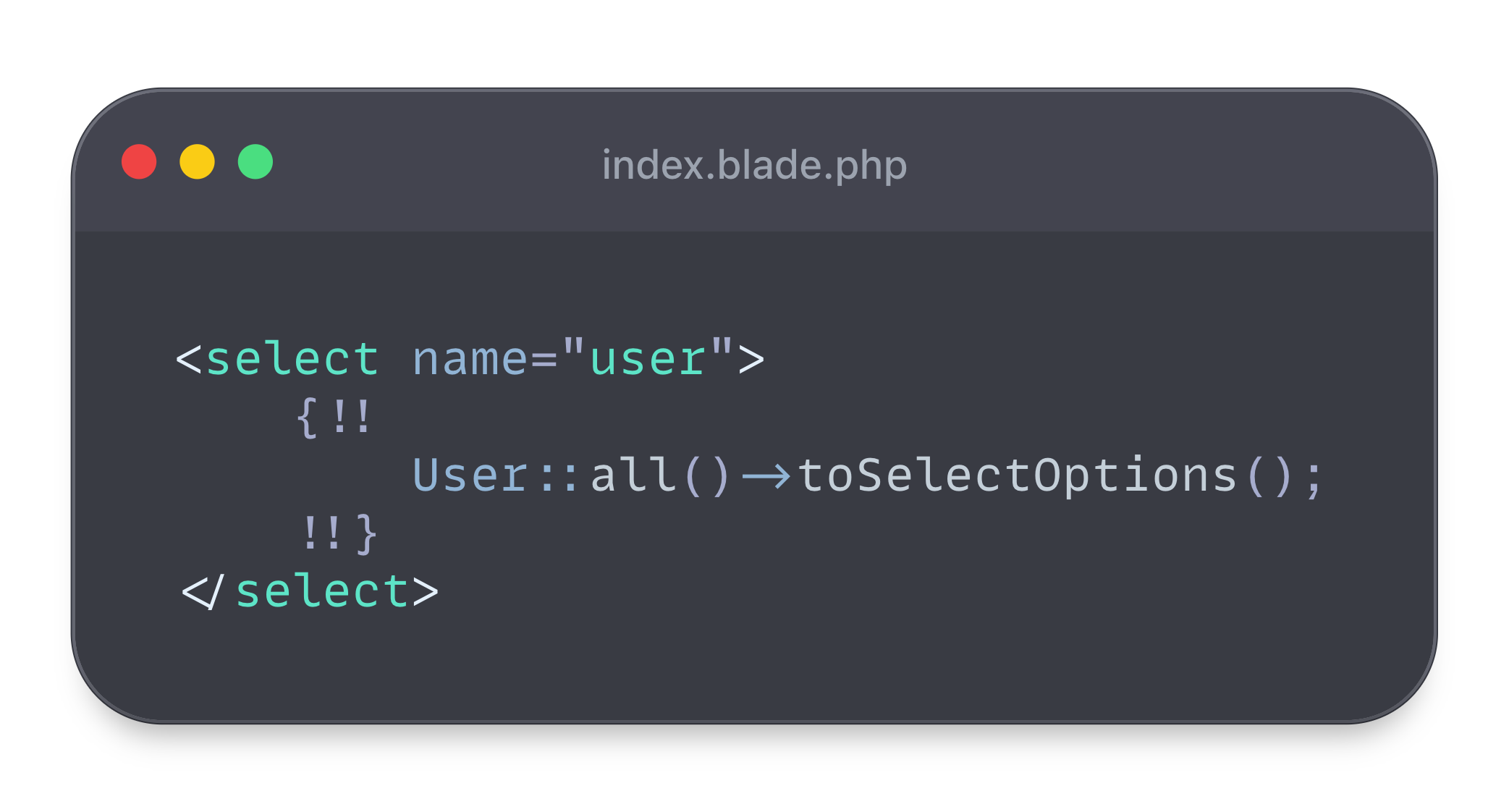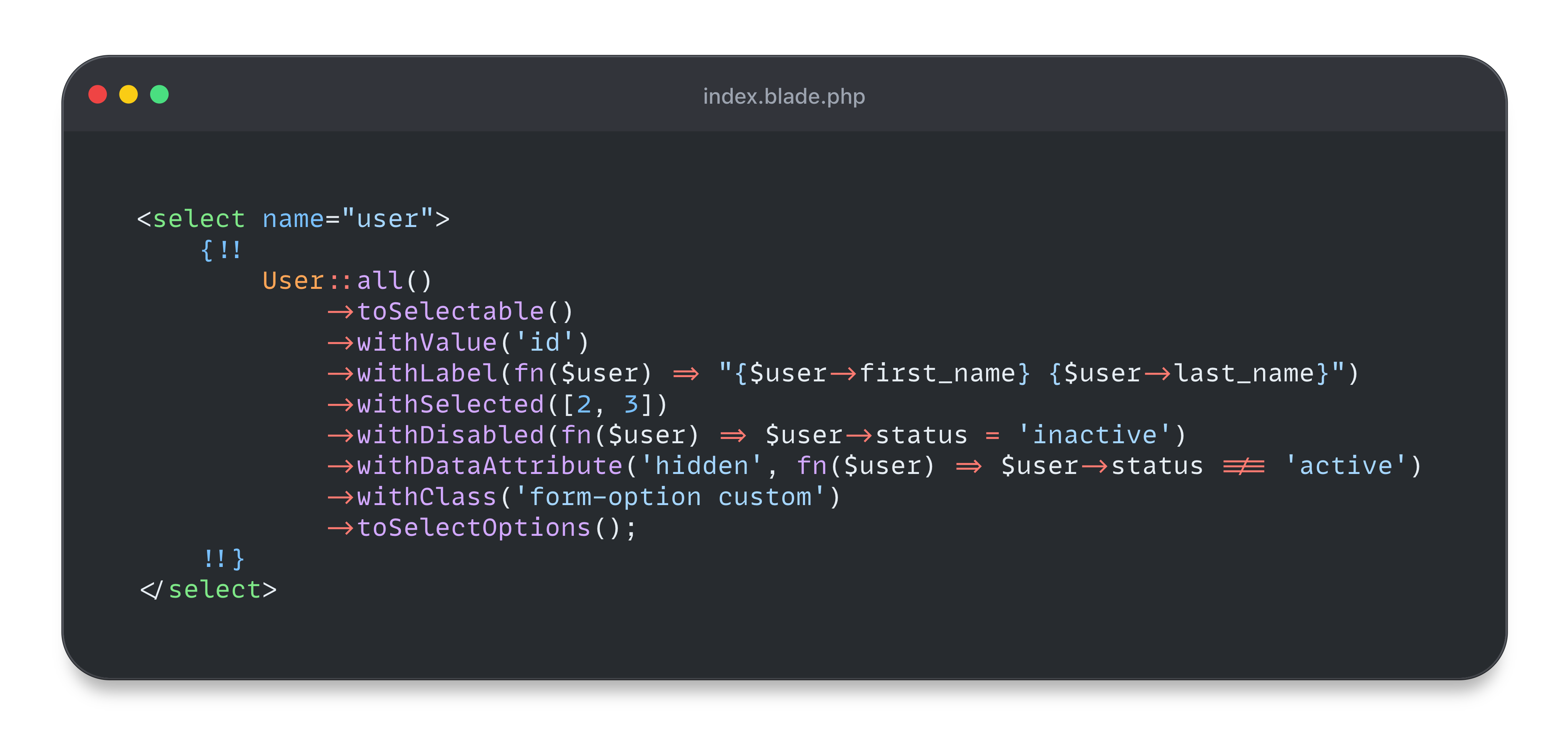Laravel Selectable
Laravel Selectable is a powerful package that simplifies the process of generating HTML select options from Laravel collections. With its flexible and intuitive syntax, you can easily create customized select options without the need for additional traits or class extensions.
Features
- Generate select options from Laravel collections with ease
- Customize label and value fields using strings or closures
- Specify selected and disabled options
- Add data attributes and classes to options
- Support for grouping options
- Convert collections to an array of selectable items for AJAX responses or SPAs
- Utilize the power Laravel's collections for more advanced filtering and sorting
Installation
You can install the package via composer:
composer require ringlesoft/laravel-selectable
No additional configuration is required.
Usage
1. Basic Usage
<select name="user_id">
{!! \\App\\Model\\User::all()->toSelectOptions(); !!}}
</select>
This will generate a select dropdown with options for all users, using the name field as the label and the id field as the value.
<select name="user_id">
<option value="{{$user->id}}">{{$user->name}}</option>
...
</select>
2. Inline Customization
<select name="user_id">
{!! \\App\\Model\\User::all()->toSelectOptions('email', 'uuid', '6490132934f22'); !!}}
</select>
This will generate a select dropdown with options for all users, using the email field as the label and the uuid
field
as the value. The selected option will be the user with the uuid 6490132934f22.
<select name="user_id">
<option value="{{$user->uuid}}" {{($user->uuid === '6490132934f22') ? 'selected' : '')}}>{{$user->email}}</option>
...
</select>
Method parameters
label: The name of the field to be used as the label for the option. If a closure is provided, the result of the closure will be used as the label. Default isname.value: The name of the field to be used as the value for the option. If a closure is provided, the result of the closure will be used as the value. Default isid.selected: The value of the item to be used as the selected option. Can be value, array of values or closure.disabled: The value of the item to be used as the disabled option. Can be value, array of values or closure.
3. Advanced Usage
This package allows building of select options from a Selectable object using method chaining.
The method toSelectable() is used to convert the collection into a Selectable object. The Selectable object has
several methods that allow you to customize the options and their properties.
<select name="user_id" multiple="multiple">
{!!
\App\Models\User::all()
->toSelectable()
->withValue('id')
->withLabel(fn($user) => "{$user->first_name} {$user->last_name}")
->withSelected([2, 3])
->withDisabled(fn($item) => $item->status = 'inactive')
->withDataAttribute('hidden', fn($item) => $item->status !== 'active')
->withClass('form-option custom')
->toSelectOptions();
!!}
</select>
This will generate a multi-select dropdown with options for all users, using the id field as the value, and a
combination of the first_name and last_name fields as the label. Options with IDs 2 and 3 will be selected by
default,
and options with an 'inactive' status will be disabled. A 'data-hidden' attribute will be added to options with
a status
other than 'active', and a custom class 'form-option custom' will be applied to all options.
<select name="user_id" multiple="multiple">
<option value="1" data-hidden="false" class="form-option custom">David Moore</option>
<option value="2" data-hidden="false" class="form-option custom">John Doe</option>
<option value="3" data-hidden="false" class="form-option custom">Jane Doe</option>
<option value="4" data-hidden="true" class="form-option custom" disabled>Mark Manson</option>
</select>
Available methods
withLabel(string|callable $label): This method allows you to customize the label for each option. A string will be used as the collection field from which the label will be generated, while a callable will be used to generate the label.withValue(string|callable $value): This method allows you to customize the value for each option. A string will be used as the collection field from which the value will be generated, while a callable will be used to generate the value.withSelected(mixed|callable $selected): This method allows you to customize the selected options. Can be astring,int, an array ofstring/int, amodelor a callable that returns a boolean value.withDisabled(mixed|callable $disabled): This method allows you to customize the disabled options. Can be astring,int, an array ofstring/int, amodelor a callable that returns a boolean value.withDataAttribute(string $attribute, mixed|callable $value): This method allows you to add a data attribute to each option.withClass(string $class): This method allows you to add a class to each option.toSelectItems(): This method converts the selectable collection to an array of selectable items. Useful for Ajax responses or SPA.toSelectOptions(): This method converts the selectable collection to an HTML select options string.- Some of the methods from
Illuminate\Support\Collectionare also available includinggroupBy().
Note: Writing queries within blade templates is not recommended. This is only for simplifying demonstration
Get Selectable Items
$selectableItems = \App\Models\User::all()->toSelectable()->toSelectItems();
This will convert the collection of users into an array of selectable items, which can be useful for AJAX responses or Single Page Applications (SPAs).
Structure of Selectable Items
[
[
'label' => 'User Name',
'value' => 'user_id',
'selected' => false,
'disabled' => false,
'dataAttributes' => ['hidden' => false],
'classes' => ['form-option', 'custom'],
],
[...]
]
Testing
composer test
Changelog
Please see CHANGELOG for more information on what has changed recently.
Contributing
Please see CONTRIBUTING for details.
Security Vulnerabilities
Please review our security policy on how to report security vulnerabilities.
Credits
- David Ringle (Author)
- All Contributors
License
The MIT License (MIT). Please see License File for more information.




